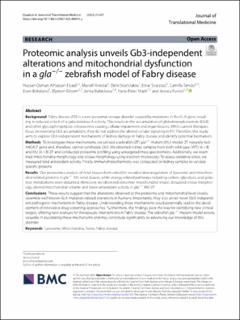| dc.contributor.author | Elsaid, Hassan Osman Alhassan | |
| dc.contributor.author | Rivedal, Mariell Lossius | |
| dc.contributor.author | Skandalou, Eleni | |
| dc.contributor.author | Svarstad, Einar | |
| dc.contributor.author | Tøndel, Camilla | |
| dc.contributor.author | Birkeland, Even | |
| dc.contributor.author | Eikrem, Øystein Solberg | |
| dc.contributor.author | Babickova, Janka | |
| dc.contributor.author | Marti, Hans Peter | |
| dc.contributor.author | Furriol, Jessica | |
| dc.date.accessioned | 2024-02-12T12:41:17Z | |
| dc.date.available | 2024-02-12T12:41:17Z | |
| dc.date.created | 2023-09-06T06:42:11Z | |
| dc.date.issued | 2023 | |
| dc.identifier.issn | 1479-5876 | |
| dc.identifier.uri | https://hdl.handle.net/11250/3116996 | |
| dc.description.abstract | Background
Fabry disease (FD) is a rare lysosomal storage disorder caused by mutations in the GLA gene, resulting in reduced or lack of α-galactosidase A activity. This results in the accumulation of globotriaosylceramide (Gb3) and other glycosphingolipids in lysosomes causing cellular impairment and organ failures. While current therapies focus on reversing Gb3 accumulation, they do not address the altered cellular signaling in FD. Therefore, this study aims to explore Gb3-independent mechanisms of kidney damage in Fabry disease and identify potential biomarkers.
Methods
To investigate these mechanisms, we utilized a zebrafish (ZF) gla−/− mutant (MU) model. ZF naturally lack A4GALT gene and, therefore, cannot synthesize Gb3. We obtained kidney samples from both wild-type (WT) (n = 8) and MU (n = 8) ZF and conducted proteome profiling using untargeted mass spectrometry. Additionally, we examined mitochondria morphology and cristae morphology using electron microscopy. To assess oxidative stress, we measured total antioxidant activity. Finally, immunohistochemistry was conducted on kidney samples to validate specific proteins.
Results
Our proteomics analysis of renal tissues from zebrafish revealed downregulation of lysosome and mitochondrial-related proteins in gla−/− MU renal tissues, while energy-related pathways including carbon, glycolysis, and galactose metabolisms were disturbed. Moreover, we observed abnormal mitochondrial shape, disrupted cristae morphology, altered mitochondrial volume and lower antioxidant activity in gla−/− MU ZF.
Conclusions
These results suggest that the alterations observed at the proteome and mitochondrial level closely resemble well-known GLA mutation-related alterations in humans. Importantly, they also unveil novel Gb3-independent pathogenic mechanisms in Fabry disease. Understanding these mechanisms could potentially lead to the development of innovative drug screening approaches. Furthermore, the findings pave the way for identifying new clinical targets, offering new avenues for therapeutic interventions in Fabry disease. The zebrafish gla−/− mutant model proves valuable in elucidating these mechanisms and may contribute significantly to advancing our knowledge of this disorder. | en_US |
| dc.language.iso | eng | en_US |
| dc.publisher | BMC | en_US |
| dc.rights | Navngivelse 4.0 Internasjonal | * |
| dc.rights.uri | http://creativecommons.org/licenses/by/4.0/deed.no | * |
| dc.title | Proteomic analysis unveils Gb3-independent alterations and mitochondrial dysfunction in a gla−/− zebrafish model of Fabry disease | en_US |
| dc.type | Journal article | en_US |
| dc.type | Peer reviewed | en_US |
| dc.description.version | publishedVersion | en_US |
| dc.rights.holder | Copyright 2023 The Author(s) | en_US |
| dc.source.articlenumber | 591 | en_US |
| cristin.ispublished | true | |
| cristin.fulltext | original | |
| cristin.qualitycode | 2 | |
| dc.identifier.doi | 10.1186/s12967-023-04475-y | |
| dc.identifier.cristin | 2172758 | |
| dc.source.journal | Journal of Translational Medicine | en_US |
| dc.identifier.citation | Journal of Translational Medicine. 2023, 21, 591. | en_US |
| dc.source.volume | 21 | en_US |
| dc.source.issue | 1 | en_US |

